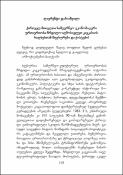Options
Economic ties of the Georgian highlanders with the peoples of the North-East Caucasus
(Khevsuri and Kist)
ISSN
1987-7374
Date Issued
2023
Abstract
This article examines the main aspects of economic ties between Georgian (Khevsur) and North Caucasian (Nakh) highlanders spanning from the late Middle Ages to the present. It is shown that the traditional agricultural practices—farming, cattle breeding, crafts, and hunting—of these mountain communities were significantly influenced by the region's unique landscape, harsh climate, and socio-political factors. The mountainous terrain and challenging climate imposed high labour costs, limited mechanization options (such as tractors and combines), and the preservation of traditional farming techniques, including the construction of terraces. Nevertheless, by the late 19th century, new crops like potatoes and corn, along with technological advancements, began to find their way into the region, gaining even more prominence in the 20th century.
Trade and craftsmanship played pivotal roles in the relations between these mountaineer communities. Khevsurs, for example, often employed stone craftsmen to construct defensive towers. Prior to the Soviet era, raiding was a common practice in the region. The policies of the Soviet government, marked by forced relocations and extensive agricultural experiments, complicated the interactions among these mountain dwellers. The resettlement of a significant portion of the Khevsurs to lower lands resulted in the abandonment of villages and the decline of traditional agricultural trades. Centuries-old economic and agricultural connections with neighbouring North Caucasian Kists gradually faded into obscurity. Moreover, in the post-Soviet period, these ties faced further limitations due to the closure of the state border between Georgia and the Russian Federation.
Trade and craftsmanship played pivotal roles in the relations between these mountaineer communities. Khevsurs, for example, often employed stone craftsmen to construct defensive towers. Prior to the Soviet era, raiding was a common practice in the region. The policies of the Soviet government, marked by forced relocations and extensive agricultural experiments, complicated the interactions among these mountain dwellers. The resettlement of a significant portion of the Khevsurs to lower lands resulted in the abandonment of villages and the decline of traditional agricultural trades. Centuries-old economic and agricultural connections with neighbouring North Caucasian Kists gradually faded into obscurity. Moreover, in the post-Soviet period, these ties faced further limitations due to the closure of the state border between Georgia and the Russian Federation.
File(s)
Loading...
Name
ქართველ მთიელთა სამეურნეო-ეკონომიკური ურთიერთობა ჩრდილო-აღმოსავლეთ კავკასიის ხალხებთან-ჯანიაშვილი ლავრენტი.pdf
Size
204.72 KB
Format
Adobe PDF
Checksum
(MD5):9ba64409f1e5a7cf54e29d7a7e736fe2